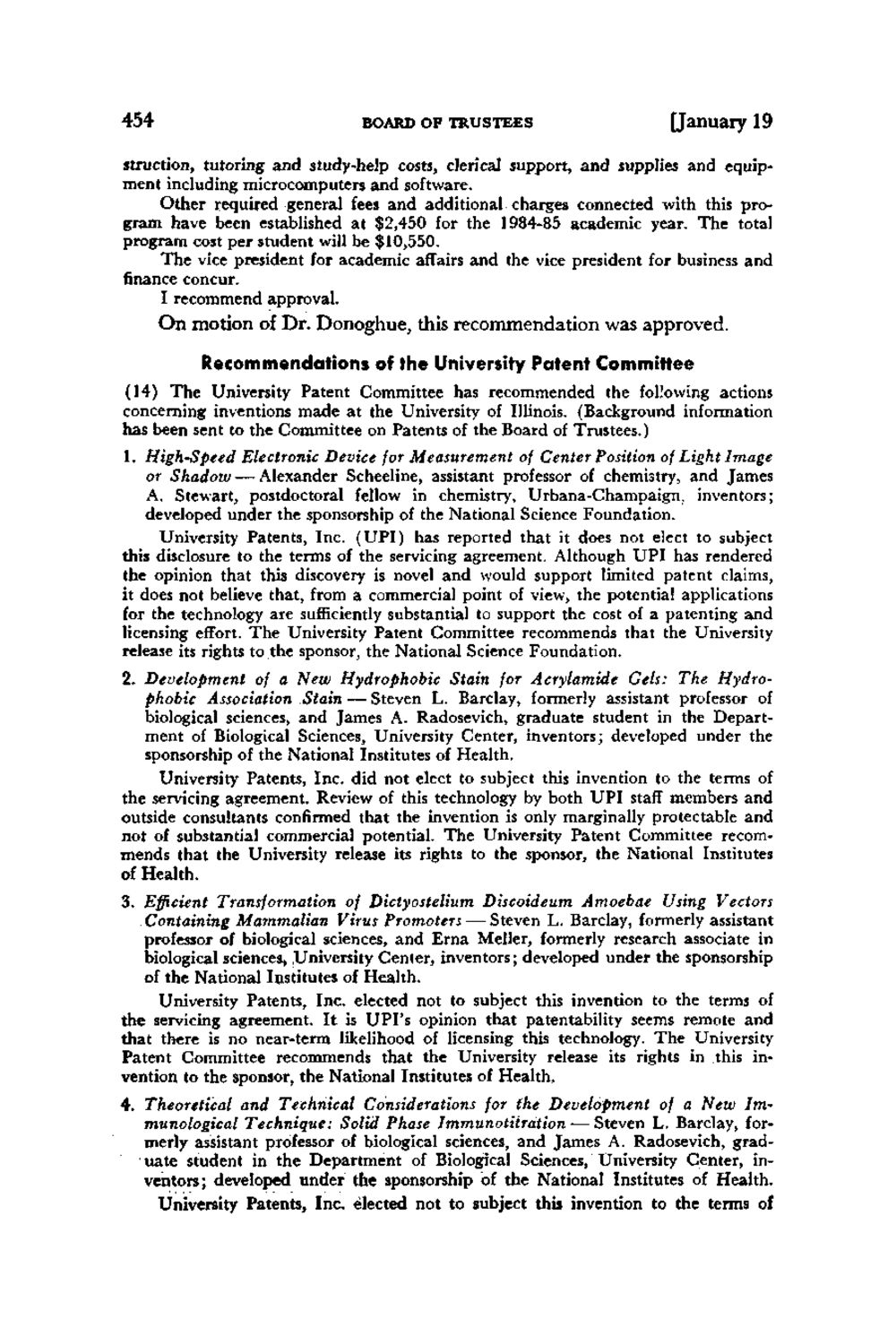| |
| |
Caption: Board of Trustees Minutes - 1984
This is a reduced-resolution page image for fast online browsing.

EXTRACTED TEXT FROM PAGE:
454 BOARD OF TRUSTEES [January 19 struction, tutoring and study-help costs, clerical support, and supplies and equipment including microcomputers and software. Other required general fees and additional charges connected with this program have been established at $2,450 for the 1984-85 academic year. The total program cost per student will be $10,550. T h e vice president for academic affairs and the vice president for business and finance concur. I recommend approval. On motion of Dr. Donoghue, this recommendation was approved. Recommendations of the University Patent Committee (14) The University Patent Committee has recommended the following actions concerning inventions made at the University of Illinois. (Background information has been sent to the Committee on Patents of the Board of Trustees.) 1. High-Speed Electronic Device for Measurement of Center Position of Light Image or Shadow — Alexander Scheeline, assistant professor of chemistry, and James A. Stewart, postdoctoral fellow in chemistry, Urbana-Champaign, inventors; developed under the sponsorship of the National Science Foundation. University Patents, Inc. ( U P I ) has reported that it does not elect to subject this disclosure to the terms of the servicing agreement. Although U P I has rendered the opinion that this discovery is novel and would support limited patent claims, it does not believe that, from a commercial point of view, the potential applications for the technology are sufficiently substantial to support the cost of a patenting and licensing effort. The University Patent Committee recommends that the University release its rights to the sponsor, the National Science Foundation. 2. Development of a New Hydrophobic Stain for Acrylamide Gels: The Hydrophobic Association Stain — Steven L. Barclay, formerly assistant professor of biological sciences, and James A. Radosevich, graduate student in the Department of Biological Sciences, University Center, inventors; developed under the sponsorship of the National Institutes of Health. University Patents, Inc. did not elect to subject this invention to the terms of the servicing agreement. Review of this technology by both U P I staff members and outside consultants confirmed that the invention is only marginally protectable and not of substantial commercial potential. The University Patent Committee recommends that the University release its rights to the sponsor, the National Institutes of Health. 3. Efficient Transformation of Dictyostelium Discoideum Amoebae Using Vectors Containing Mammalian Virus Promoters •— Steven L. Barclay, formerly assistant professor of biological sciences, and Erna Meller, formerly research associate in biological sciences, University Center, inventors; developed under the sponsorship of the National Institutes of Health. University Patents, Inc. elected not to subject this invention to the terms of the servicing agreement. It is UPI's opinion that patentability seems remote and that there is no near-term likelihood of licensing this technology. The University Patent Committee recommends that the University release its rights in this invention to the sponsor, the National Institutes of Health, 4. Theoretical and Technical Considerations for the Development of a New Immunological Technique: Solid Phase Jmmunotiirdtion — Steven L. Barclay, formerly assistant professor of biological sciences, and James A. Radosevich, graduate student in the Department of Biological Sciences, University Center, inventors; developed under the sponsorship of the National Institutes of Health. University Patents, Inc. elected not to subject this invention to the terms of
| |